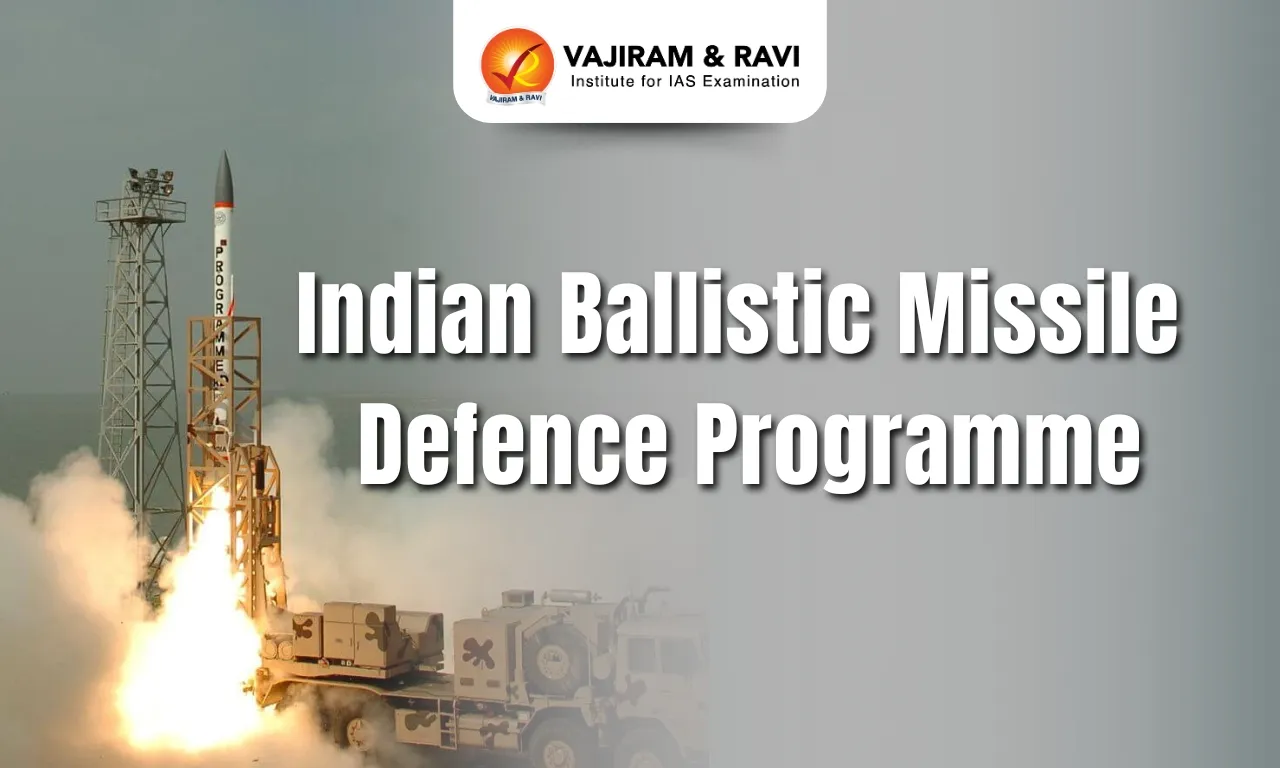The Indian Ballistic Missile Defence (BMD) Programme, launched in 2000 post-Kargil War, is pivotal in safeguarding India against missile threats, primarily from Pakistan and China. Utilising a multi-layered approach, it deploys two interceptor missiles: Prithvi Air Defence for high altitudes and Advanced Air Defence for lower altitudes.
More recently, efforts have focused on improving capabilities through global cooperation and serial manufacture, as seen by the acquisition of the Russian S-400 Triumf system. Phase two, led by DRDO, is dedicated to developing anti-ballistic systems such as THAAD, while projects like AD-II focus on missiles with a longer range.
In light of shifting geopolitics, India’s commitment to national security is emphasised by the Ballistic Missile Defence Programme.
Origin of India’s Ballistic Missile Defence Systems
Strategic missiles are either of the cruise or ballistic type. Cruise missiles are jet-propelled at subsonic speeds throughout their flights, while ballistic missiles are rocket-powered only in the initial (boost) phase of flight, after which they follow an arcing trajectory to the target.
- In response to the growing threat from China and Pakistan missiles and the subsequent nuclearisation of the subcontinent, India initiated a BMD system in 2000.
- The DRDO was tasked with developing an indigenous multi-tier network to counter missiles with up to 2000 km and 5000 km ranges in Phases 1 and 2, respectively.
- This strategic move aimed to protect against evolving missile threats in the region.
Components of India’s BMD Network
A ballistic missile follows a high-arched trajectory and is powered only during the initial launch phase. Ballistic missiles can be equipped with conventional or Weapons of Mass Destruction (WMD) payloads and pose a grave security threat.
- Detection and tracking: Long-range surveillance radars like Swordfish detect incoming missiles and multi-object tracking radars continuously monitor their trajectory.
- Command and control centres: Mission control centres analyse real-time tracking data to ascertain missile trajectory, launch interceptors and coordinate appropriate response measures across the network.
- Interceptor launchers: These are containers that store interceptor missiles linked with the tracking and command nodes.
- Launchers fitted with electromechanical systems eject missiles at hostile projectiles based on trajectory predictions.
- Communications network: Reliable communication connectivity between the sensors, interceptors and control centres using wired or high-frequency radio links essential for coordinated BMD functioning.
India’s Two-Tier Ballistic Missile Defence System
As conceived in original plans, India’s BMD shield comprises two interceptor missile systems – Prithvi Air Defence (PAD) and Advanced Air Defence (AAD) missiles with specialised capabilities:
High Altitude PAD Interceptors
The Prithvi interceptors are designed to tackle longer-range ballistic missiles above (50km-80km) altitudes in exo-atmospheric space. Two PAD variants are developed:

- Pradyumna Missile: It is a two-stage solid and liquid-fueled quick-reaction missile to intercept incoming missiles at 80 km altitude with a maximum speed of Mach 5.
- Prithvi Defence Vehicle: Advanced variant consisting of a kinetic kill vehicle attached to the top of dual stage PAD interceptor instead of explosives.
- It collides directly with hostile missiles above the atmosphere.
Lower Altitude AAD Interceptors
The Advanced Air Defence missiles provide an additional interception layer engaging enemy missiles endo-atmospherically in the 15 to 30 km altitude range:

- AAD Ashwin Interceptors: Single-stage solid rocket-propelled missiles that can attain 4.5 Mach speeds, 100 km range and 20 km operational altitude to neutralise hostile projectiles.
Together, the PAD and AAD interceptors form a robust and impenetrable missile shield reducing leakage of hostile missiles significantly.
Key Missile Technologies Demonstrated
The IBMDP is an ambitious initiative to protect India from incoming ballistic missile threats. It aims to deploy a multi-layered system with the following key capabilities:
- Advanced Interceptor Missiles: These high-speed missiles are designed to intercept and physically destroy incoming enemy ballistic missiles while in flight.
- For example, the PAD missile can intercept hostile missiles at high altitudes within the atmosphere.
- Phased array radars: These advanced radars are critical for detecting and tracking incoming ballistic missiles.
- They utilise multiple scanning beams electronically to provide detailed trajectory data on speed, direction and projected point of impact.
- The Swordfish radar is one such Indian phased array radar incorporated into the defence shield.
- They utilise multiple scanning beams electronically to provide detailed trajectory data on speed, direction and projected point of impact.
- Command and Control Systems: Sophisticated command and control systems like the Integrated Air Command & Control System (IACCS) enable coordination between detection platforms, interceptor missiles and higher command centres.
- This allows efficient data sharing and calibrated responses.
- Sea-based defence: India has developed ship-based anti-ballistic missile systems to enable interception of missiles from naval vessels.
- For instance, a recent successful test demonstrates this capability from INS Anvesh.
- Terminal Ballistic Missile Defense: Terminal systems like the land-based two-tier ballistic missile defence network developed by DRDO can destroy incoming missiles in their final flight phase over important targets.
- Future Developments: The program is focused on the development of cutting-edge technologies like hypersonic glide vehicles, capable of travelling at speeds greater than Mach 5.
- It also aims to advance radar technology for improved detection and tracking capabilities
Significance of the Ballistic Missile Defence Programme
The Indian Ballistic Missile Defense Programme is a strategic initiative critical to India’s national security. It aims to provide a robust shield against incoming ballistic missile threats through an integrated multi-layered system.
- National security: The IBMDP is vital for India to defend against missile attacks that can target key assets and major population centres.
- Intercepting adversarial missiles acts as a protective barrier and enhances India’s security in an evolving threat environment.
- Regional threats: The detection and interception capabilities, enable India to counter missile threats from adversarial nations in the region.
- Successful interceptions of incoming missiles by the DRDO demonstrate this strategic capability as an active deterrent.
- Nuclear Arsenal: With nuclear weapons, India faces risks of pre-emptive strikes. An effective missile defence shield reduces the chances of nuclear assets being compromised, thereby fortifying India’s deterrence posture.
- Technological capabilities: Developing unique technologies like missile interceptors and modern radars stimulates the indigenous defence industry, helping India become self-reliant in critical domains.
- This brings advancements aligned with the future needs of the armed forces.
- International Cooperation: India’s progress in this sphere has led countries like the USA with shared security interests in Asia to actively collaborate and exchange missile defence technologies.
- This highlights the credibility of Indian missile defence capabilities globally.
Challenges associated with the Ballistic Missile Defence Programme
The Indian Ballistic Missile Defense system aims to provide missile shield security to the nation against incoming threats, but faces multiple challenges:
- Technological complexity: The system integrates specialised technologies like interceptor missiles, tracking radars and command centres.
- Technical issues faced in developing key interception missiles like the AAD exemplify the sophisticated technological barriers.
- Limited Interceptor range: Current operational Indian interceptor missiles have a maximum interception range of around 80 km only.
- This significantly limits defence coverage against adversary longer-range missile strikes.
- Simultaneous Multi-vector threats: India faces likely threats from multiple geographies simultaneously.
- Providing 360-degree missile defence with current systems against synchronised attacks is still an operational challenge.
- Resource and Cost implications: The substantial investments required to place a strain on budgets and skill allocations.
- This has opportunity costs with funds being diverted from conventional capacity upgrades. Balancing the allocation of resources between offensive and defensive capabilities is a challenge for India.
- This challenge is exemplified by the need to prioritise investments in both conventional and strategic deterrence.
- Fast-advancing threat dynamics: Adversaries are rapidly modernising missile technologies and may employ counter-measures too.
- India has to expend efforts continuously to upgrade systems against an unpredictably progressing threat.
- Technology access issues: Despite external partnerships, India’s indigenous missile defence relies considerably on technology transfer and access to controlled items.
- Export control regimes affect technology availability due to global non-proliferation norms.
India’s nuclear and long-range missile programs are key to maintaining strategic stability in the Asia-Pacific region and achieving great-power status. With indigenous missile design and manufacturing capabilities, India can deploy various ballistic missiles.
Last updated on April, 2025
→ UPSC Notification 2025 was released on 22nd January 2025.
→ The UPSC Vacancy 2025 were released 1129, out of which 979 were for UPSC CSE and remaining 150 are for UPSC IFoS.
→ As per UPSC Notification, the last date to apply is 18th February 2025.
→ The UPSC Prelims 2025 is scheduled to be conducted on 25th May 2025 and UPSC Mains 2025 will be conducted on 22nd August 2025.
→ Apply once through it and aspirants can apply for various government exams conducted by UPSC.
→ The UPSC Selection Process is of 3 stages-Prelims, Mains and Interview.
→ UPSC Result 2024 is released with latest UPSC Marksheet 2024. Check Now!
→ UPSC Toppers List 2024 is released now. Shakti Dubey is UPSC AIR 1 2024 Topper.
→ Also check Best IAS Coaching in Delhi
Indian Ballistic Missile Defence Programme FAQs
Q1. What is an air defence system?+
Q2. Which interceptors are developed under the Indian Ballistic Missile Defence Programme?+
Q3. What is the significance of the Indian Ballistic missile defence programme?+
Q4. Why does India need a ballistic missile Defence system?+
Q5. What are the limitations of the Indian Ballistic missile defence programme?+















